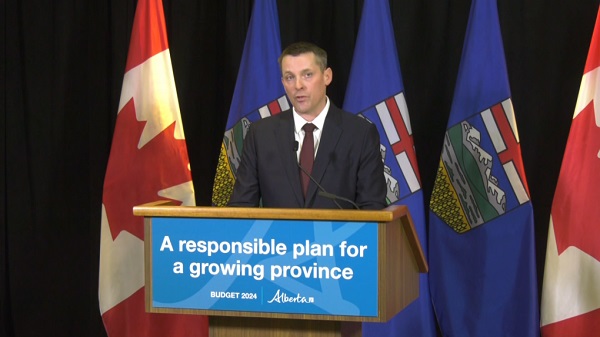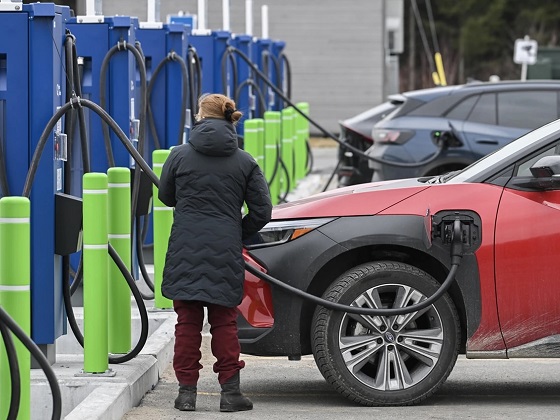Alberta
Alberta 2025 Budget Review from the Alberta Institute

The government has just tabled its budget in the Legislature.
We were invited to the government’s advance briefing, which gave us a few hours to review the documents, ask questions, and analyze the numbers before the official release.
Now that the embargo has been lifted, we can share our thoughts with you.
However, this is just our preliminary analysis – we’ll have a more in-depth breakdown for you next week.
*****
The 2025/26 Budget is a projection for the next year – what the government expects will happen from April 1st, 2025 to March 31st, 2026.
It represents the government’s best estimate of future revenue and its plan for expenditures.
In the budget (and in this email) this type of figure is referred to as a Budget figure.
*****
The actual final figures won’t be known until the 2025/26 Annual Report is released in the middle of next year.
Of course, as we’ve seen in the past, things don’t always go according to plan.
In the budget (and in this email) this type of figure is referred to as an Actual figure.
Importantly, this means that the 2024/25 Annual Report isn’t ready yet, either.
*****
Therefore, in the meantime, the Q3 2025/26 Fiscal Update, which has figures up to December 31st, 2024, provides a forecast for the 2024/25 year.
The government looks at the actual results three quarters of the way through the previous year, and uses those figures to get the most accurate forecast on what will be the final result in the annual report, to help with estimating the 2025-26 year.
In the budget (and in this email) this type of figure is referred to as a Forecast figure.
*****
Accurately estimating, and tracking these three types of figures is a key part of good budgeting.
Sometimes, the economy performs better than expected, oil prices could be higher than initially forecast, or more revenue may come in from other sources.
But, other times, there’s a recession or a drop in oil prices, leading to lower-than-expected revenue.
On the spending side, governments sometimes find savings, keeping expenses lower than planned.
Alternatively, unexpected costs, disasters, or just governments being governments can also drive spending higher than budgeted.
The best way to manage this uncertainty is:
- Be conservative in estimating revenue.
- Only plan to spend what is reasonably expected to come in.
- Stick to that spending plan to avoid overspending.
By following these principles, the risk of an unexpected deficit is minimized.
And if revenue exceeds expectations or expenses come in lower, the surplus can be used to pay down debt or be returned to taxpayers.
On these three measures, this year’s budget gets a mixed grade.
*****
On the first point, the government has indeed made some pretty conservative estimates of revenue – including assuming an oil price several dollars below where it currently stands, and well below the previous year’s predictions.
The government has also assumed there will be some significant (though not catastrophic) effects from a potential trade war.
If oil prices end up higher, or Canada avoids a trade war with the US, then revenue could be significantly higher than planned.
Interestingly, this year’s budget looks very different depending on whether you compare it to last year’s budget, or the latest forecast.
This year’s budget revenue is $6.6 billion lower than what actually happened in last year’s forecast revenue.
But, this year’s budget revenue is actually $600 million higher than what was expected to happen in last year’s budget revenue.
In other words, if you compare this year’s budget to what the government expected to happen last year, revenue is up a small amount, but when you compare this year’s budget to what actually happened last year, revenue is down a lot.
*****
On the second point, unfortunately, the government doesn’t score so well.
Expenses are up quite a bit, even though revenue is expected to drop.
According to some measurements, expenditures are increasing slower than the combined rate of population growth and inflation – which is the goal the government set for itself in 2023.
But, when other expenses like contingencies for emergencies are included, or when expenses are measured in other ways, spending is increasing faster than that benchmark.
This year’s budget expenses are $4.4 billion higher than what was actually spent in last year’s forecast expenses.
But, this year’s budget expenses are $6.1 billion higher than what was expected to happen in last year’s budget expenses.
Perhaps the bigger question is why is expenditure increasing at all when revenue is expected to drop?
If there’s less money coming in, the government should really be using this as an opportunity to reduce overall expenditures.
*****
On the third point, we will – of course – have to wait and see what the final accounts look like next year!
*****
Before we wrap up this initial analysis, there’s one aspect of the budget that is likely to receive significant attention, and that is a tax cut.
Originally planned to be phased in over the next few years, a tax cut will now be back-dated to January 1st of this year.
Previously, any income below about $150,000 was subject to a 10% provincial tax, while incomes above $150,000 attract higher and higher tax rates of 12%, 13%, 14%, and 15% as incomes increase.
Under the new tax plan, incomes under $60,000 would only be taxed at 8%, with incomes between $60,000 and $150,000 still paying 10%, and incomes above $150,000 still paying 12%, 13%, 14%, and 15%, as before.
Some commentators are likely to question the wisdom of a tax cut that reduces revenue when the budget is going to be in deficit.
But, the reality is that this tax cut doesn’t actually cost much.
We’ll have the exact figures for you by next week, but suffice to say that it’s a pretty small portion of the overall deficit, and there’s a deficit because spending is up a lot, not because of a small tax cut.
In general, lower taxes are good, but we would have preferred the government work towards a lower, flatter tax instead.
The Alberta Advantage was built on Alberta’s unique flat tax system where everyone paid the same low flat tax (not the same amount, the same percentage!) and so wasn’t punished for succeeding.
Alberta needs a plan to get back to a low flat tax, and we will continue to advocate for this at the Alberta Institute.
Maybe we can do better than just returning to the old 10% flat tax, though?
Maybe we should aim for a flat tax of 8%, instead?
That’s it for today’s quick initial analysis.
In next week’s analysis, we’ll break down the pros and cons of these decisions and outline where we might have taken a different approach.
In the meantime, if you appreciate our work and want to support more of this kind of independent analysis of Alberta’s finances, please consider making a donation here:
Alberta
Premier Smith: Canadians support agreement between Alberta and Ottawa and the major economic opportunities it could unlock for the benefit of all

From Energy Now
By Premier Danielle Smith
Get the Latest Canadian Focused Energy News Delivered to You! It’s FREE: Quick Sign-Up Here
If Canada wants to lead global energy security efforts, build out sovereign AI infrastructure, increase funding to social programs and national defence and expand trade to new markets, we must unleash the full potential of our vast natural resources and embrace our role as a global energy superpower.
The Alberta-Ottawa Energy agreement is the first step in accomplishing all of these critical objectives.
Recent polling shows that a majority of Canadians are supportive of this agreement and the major economic opportunities it could unlock for the benefit of all Canadians.
As a nation we must embrace two important realities: First, global demand for oil is increasing and second, Canada needs to generate more revenue to address its fiscal challenges.
Nations around the world — including Korea, Japan, India, Taiwan and China in Asia as well as various European nations — continue to ask for Canadian energy. We are perfectly positioned to meet those needs and lead global energy security efforts.
Our heavy oil is not only abundant, it’s responsibly developed, geopolitically stable and backed by decades of proven supply.
If we want to pay down our debt, increase funding to social programs and meet our NATO defence spending commitments, then we need to generate more revenue. And the best way to do so is to leverage our vast natural resources.
At today’s prices, Alberta’s proven oil and gas reserves represent trillions in value.
It’s not just a number; it’s a generational opportunity for Alberta and Canada to secure prosperity and invest in the future of our communities. But to unlock the full potential of this resource, we need the infrastructure to match our ambition.
There is one nation-building project that stands above all others in its ability to deliver economic benefits to Canada — a new bitumen pipeline to Asian markets.
The energy agreement signed on Nov. 27 includes a clear path to the construction of a one-million-plus barrel-per-day bitumen pipeline, with Indigenous co-ownership, that can ensure our province and country are no longer dependent on just one customer to buy our most valuable resource.
Indigenous co-ownership also provide millions in revenue to communities along the route of the project to the northwest coast, contributing toward long-lasting prosperity for their people.
The agreement also recognizes that we can increase oil and gas production while reducing our emissions.
The removal of the oil and gas emissions cap will allow our energy producers to grow and thrive again and the suspension of the federal net-zero power regulations in Alberta will open to doors to major AI data-centre investment.
It also means that Alberta will be a world leader in the development and implementation of emissions-reduction infrastructure — particularly in carbon capture utilization and storage.
The agreement will see Alberta work together with our federal partners and the Pathways companies to commence and complete the world’s largest carbon capture, utilization and storage infrastructure project.
This would make Alberta heavy oil the lowest intensity barrel on the market and displace millions of barrels of heavier-emitting fuels around the globe.
We’re sending a clear message to investors across the world: Alberta and Canada are leaders, not just in oil and gas, but in the innovation and technologies that are cutting per barrel emissions even as we ramp up production.
Where we are going — and where we intend to go with more frequency — is east, west, north and south, across oceans and around the globe. We have the energy other countries need, and will continue to need, for decades to come.
However, this agreement is just the first step in this journey. There is much hard work ahead of us. Trust must be built and earned in this partnership as we move through the next steps of this process.
But it’s very encouraging that Prime Minister Mark Carney has made it clear he is willing to work with Alberta’s government to accomplish our shared goal of making Canada an energy superpower.
That is something we have not seen from a Canadian prime minister in more than a decade.
Together, in good faith, Alberta and Ottawa have taken the first step towards making Canada a global energy superpower for benefit of all Canadians.
Danielle Smith is the Premier of Alberta
Alberta
A Memorandum of Understanding that no Canadian can understand

From the Fraser Institute
The federal and Alberta governments recently released their much-anticipated Memorandum of Understanding (MOU) outlining what it will take to build a pipeline from Alberta, through British Columbia, to tidewater to get more of our oil to markets beyond the United States.
This was great news, according to most in the media: “Ottawa-Alberta deal clears hurdles for West Coast pipeline,” was the top headline on the Globe and Mail’s website, “Carney inks new energy deal with Alberta, paving way to new pipeline” according to the National Post.
And the reaction from the political class? Well, former federal environment minister Steven Guilbeault resigned from Prime Minister Carney’s cabinet, perhaps positively indicating that this agreement might actually produce a new pipeline. Jason Kenney, a former Alberta premier and Harper government cabinet minister, congratulated Prime Minister Carney and Premier Smith on an “historic agreement.” Even Alberta NDP Leader Naheed Nenshi called the MOU “a positive step for our energy future.”
Finally, as Prime Minister Carney promised, Canada might build critical infrastructure “at a speed and scale not seen in generations.”
Given this seemingly great news, I eagerly read the six-page Memorandum of Understanding. Then I read it again and again. Each time, my enthusiasm and understanding diminished rapidly. By the fourth reading, the only objective conclusion I could reach was not that a pipeline would finally be built, but rather that only governments could write an MOU that no Canadian could understand.
The MOU is utterly incoherent. Go ahead, read it for yourself online. It’s only six pages. Here are a few examples.
The agreement states that, “Canada and Alberta agree that the approval, commencement and continued construction of the bitumen pipeline is a prerequisite to the Pathways project.” Then on the next line, “Canada and Alberta agree that the Pathways Project is also a prerequisite to the approval, commencement and continued construction of the bitumen pipeline.”
Two things, of course, cannot logically be prerequisites for each other.
But worry not, under the MOU, Alberta and Ottawa will appoint an “Implementation Committee” to deliver “outcomes” (this is from a federal government that just created the “Major Project Office” to get major projects approved and constructed) including “Determining the means by which Alberta can submit its pipeline application to the Major Projects Office on or before July 1, 2026.”
What does “Determining the means” even mean?
What’s worse is that under the MOU, the application for this pipeline project must be “ready to submit to the Major Projects Office on or before July 1, 2026.” Then it could be another two years (or until 2028) before Ottawa approves the pipeline project. But the MOU states the Pathways Project is to be built in stages, starting in 2027. And that takes us back to the circular reasoning of the prerequisites noted above.
Other conditions needed to move forward include:
The private sector must construct and finance the pipeline. Serious question: which private-sector firm would take this risk? And does the Alberta government plan to indemnify the company against these risks?
Indigenous Peoples must co-own the pipeline project.
Alberta must collaborate with B.C. to ensure British Columbians get a cut or “share substantial economic and financial benefits of the proposed pipeline” in MOU speak.
None of this, of course, addresses the major issue in our country—that is, investors lack clarity on timelines and certainty about project approvals. The Carney government established the Major Project Office to fast-track project approvals and provide greater certainty. Of the 11 project “winners” the federal government has already picked, most either already had approvals or are already at an advanced stage in the process. And one of the most important nation-building projects—a pipeline to get our oil to tidewater—hasn’t even been referred to the Major Project Office.
What message does all this send to the investment community? Have we made it easier to get projects approved? No. Have we made things clearer? No. Business investment in Canada has fallen off a cliff and is down 25 per cent per worker since 2014. We’ve seen a massive outflow of capital from the country, more than $388 billion since 2014.
To change this, Canada needs clear rules and certain timelines for project approvals. Not an opaque Memorandum of Understanding.
-

 National1 day ago
National1 day agoMedia bound to pay the price for selling their freedom to (selectively) offend
-

 Bruce Dowbiggin1 day ago
Bruce Dowbiggin1 day agoSometimes An Ingrate Nation Pt. 2: The Great One Makes His Choice
-

 Business20 hours ago
Business20 hours agoRecent price declines don’t solve Toronto’s housing affordability crisis
-

 Daily Caller21 hours ago
Daily Caller21 hours agoTech Mogul Gives $6 Billion To 25 Million Kids To Boost Trump Investment Accounts
-

 MAiD22 hours ago
MAiD22 hours agoHealth Canada report finds euthanasia now accounts for over 5% of deaths nationwide
-

 Automotive14 hours ago
Automotive14 hours agoPower Struggle: Governments start quietly backing away from EV mandates
-

 Energy13 hours ago
Energy13 hours agoUnceded is uncertain
-

 Business15 hours ago
Business15 hours agoNew Chevy ad celebrates marriage, raising children




